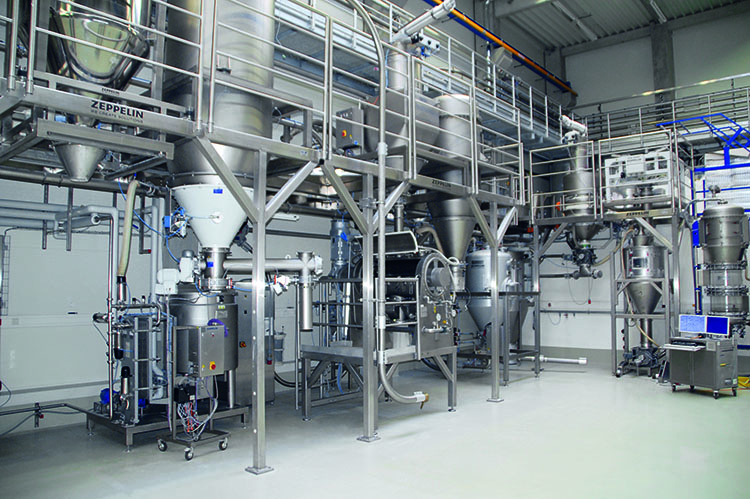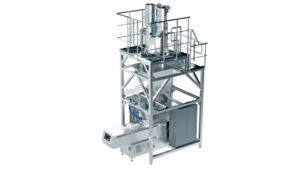
The new modular Codos® kneading system
Zeppelin’s new CODOS® mixing and kneading system also brings innovations for continuous operations. After modernization and reworking, the Codos® system concept has been repositioned and introduced to the market as Fresh-Up, a modular mixing and kneading system with new components. The complete system consists of a CODOS® tower, a DymoMix® and a CODOS® NT kneader. The CODOS® tower is the initial unit in the system. It consists of a storage container with a mixing tool and a differential weigh feeder positioned underneath to produce a continuous and constant mass flow of powdered raw materials.
The DymoMix® hydration system can be used as a premixer in the Codos® system and as a complementary production step between dosing and kneading of doughs or other further processing steps. “The special feature is that powdery components are hydrated with water or oil, immediately forming a homogeneous mixture. This procedure allows the production of improved-quality dough. Hydrating with water or oil is accomplished by a specially-designed nozzle built into the rotating shaft of the unit. This forms a liquid film through which the powdered particles must pass, becoming hydrated. Unlike conventional systems, a high-pressure water jet is not used for hydration. As a result, even with low moisture contents, a high-quality product can be produced, ready to be processed immediately without intermediate steps,” Dr. Christian Faber, Senior Technology Consulting, Zeppelin Systems, elaborates. The CODOS® tower and DymoMix® and CODOS® NT kneaders can be used in different combinations, for different applications.

The dough is formed in the horizontally operating continuous CODOS® NT kneader. “Special helical interlocking twin shafts apply the energy required for kneading to the dough. This forms the gluten structure of the wheat dough.
The bow shape of the kneading attachments on the twin shafts ensures gentle kneading without cutting the dough. The energy input required for the specific product can be controlled via the speed of the kneading shafts, as can the dwell time of the dough. Thanks to a double-walled, temperature-controlled trough design, the dough always maintains the desired temperature. This allows the specified temperature of the dough to be maintained within narrow limits,” Faber explains.
With an output range between 500 and 6,000 kg/h, the new generation of CODOS® NT is a step up in terms of capacity and efficiency over previous models. Advantages include precise temperature control, raw material metering accuracy, and low energy and maintenance requirements. The main area of application for the CODOS® system are monolines, where production can run around the clock. The same system can be used for doughs with broadly differing requirements and characteristics.
Read the full article in Baking+Biscuit International, issue 2.
Related articles:


